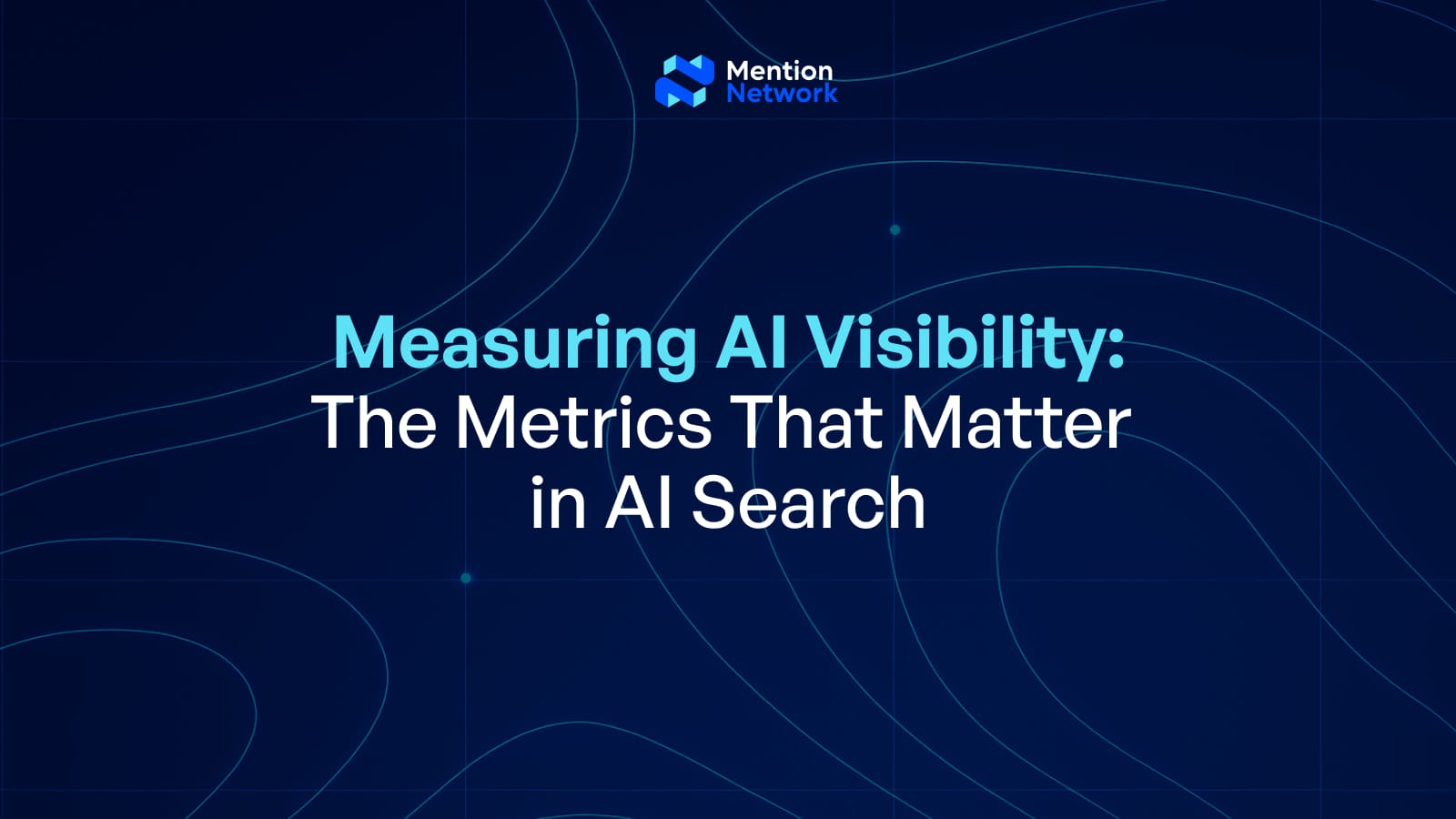Measuring AI Visibility: The Metrics That Matter in AI Search

AI search is reshaping how people discover brands. Instead of clicking through links, users now receive synthesized answers from ChatGPT, Perplexity, Claude, and Google Gemini. This shift makes visibility inside AI-generated responses just as important as traditional rankings. AI visibility shows whether models recognize, trust, and cite your brand when users ask questions that matter. Understanding these metrics is now a core skill for marketers, SEOs, developers, and founders navigating an AI-driven discovery landscape.
- AI visibility measures how often AI models mention or cite your brand in generated answers
- SEO rankings do not guarantee AI visibility, both systems use different trust signals
- Share of voice, citation share, and topic visibility are essential AI search metrics
- Structured content and entity clarity directly influence AI visibility
- Tracking visibility across multiple AI models reveals platform strengths and weaknesses
1. AI Visibility Begins With Answer Presence
Answer presence is the foundation of AI visibility because it measures how often your brand appears in AI-generated responses.
Answer presence reflects the frequency with which AI models mention your brand across thousands of topic-specific queries. It is the most direct indicator of whether AI systems consider you relevant enough to include in an answer.
Why it matters
- Shows real visibility in zero-click environments
- Uncovers whether AI systems understand your brand’s role in the category
- Helps compare brand presence across multiple AI platforms
How it works
AI models interpret a user query, evaluate trusted sources, and synthesize an answer. During this process, they may reference your brand if your domain or entity appears authoritative.
Example
If your brand is referenced in 70 percent of AI responses for onboarding queries but only 15 percent for security topics, your visibility is uneven and requires strategic focus.
Common mistakes
- Assuming high SEO ranking ensures AI mention
- Only measuring branded queries
- Ignoring the content quality signals AI relies on
2. Share of Voice Reveals Competitive Weight in AI Search
Share of voice measures how much of the total AI conversation your brand occupies compared to competitors.
This metric goes beyond appearance rate and shows how dominant your brand is in AI-generated recommendations. It provides a holistic view of your competitive footprint in AI search.
Why it matters
- Identifies category leaders within AI-generated answers
- Shows whether your brand controls the narrative
- Helps uncover overperforming or underperforming competitors
How it works
Share of voice = Your brand mentions / Total brand mentions across all AI answers
Comparison Table
Common mistakes
- Measuring SOV only monthly instead of by industry, topic, and model
- Confusing high volume with high reliability
- Ignoring emerging competitors gaining momentum
3. Citation Share Shows Whether AI Trusts Your Content

Citation share reveals how often AI models use your domain as a source, which is a direct indicator of trust.
Citations act as the AI equivalent of backlinks. When a model cites your content, it signals confidence in your accuracy, structure, and authority.
Why it matters
- High citation share increases chances of being referenced again
- Strong citations help you win new queries and categories
- Reveals whether AI views your site as factually reliable
How it works
Citation share tracks:
- Citations of your domain
- Citations of competitor domains
- Third-party citations (news, reviews, encyclopedic sources)
Example
Your brand may appear often in AI answers but rarely be cited. That means AI models know your brand exists but do not fully trust your content structure or factual depth.
Common mistakes
- Publishing long articles without structured clarity
- Ignoring schema markup and factual sourcing
- Assuming traffic equals authority
You can track this using Mention Network
With the Mention Network Brand Visibility Report, you can see:
- How often each AI model cites your domain
- Whether your citation share is rising or falling over time
- Which competitors receive more citations
- Which topics drive the most citations or where you are absent
This gives you a clear diagnostic of how much AI trusts you, where you are losing authority, and what needs improvement.
4. AI Model Distribution Shows Platform-Specific Performance
AI models differ significantly in how they generate answers, so visibility must be measured per model.
ChatGPT, Perplexity, Gemini, Claude, and DeepSeek all use different ranking signals, data sources, and synthesis styles. Optimizing for only one leads to incomplete visibility.
Why it matters
- Reveals platforms where you are strong or weak
- Helps allocate optimization effort based on model behavior
- Tracks emerging platforms gaining influence
How it works
Evaluate presence and citations separately for each model. Some may over-cite third-party domains, while others may favor structured websites or authoritative institutions.
Example
If you have high presence in ChatGPT but weak presence in Gemini, the issue may be entity clarity, schema markup gaps, or insufficient structured data.
Common mistakes
- Optimizing only for ChatGPT exposure
- Ignoring Google Gemini despite its rapid integration into search
- Assuming all AI models rank sources the same way
5. Topic-Level Visibility Reveals True Strength Across User Intent
Topic visibility shows how your brand performs across specific search categories, not just aggregated results.
Measuring visibility by topic uncovers areas where your brand leads, gaps where competitors dominate, and opportunities for fast growth.
Why it matters
- Provides actionable direction for content strategy
- Shows how AI perceives your expertise across subtopics
- Helps prioritize content updates and expansions
How it works
AI visibility platforms group prompts into themes such as:
- Pricing
- Security
- Product reviews
- Tutorials
- Troubleshooting
- Comparisons
Then they calculate visibility per topic cluster.
Example
A brand might dominate the “Trading Fees” topic but perform poorly in “Security Features”. This helps teams understand exactly where to invest next.
Common mistakes
- Focusing solely on branded queries
- Ignoring long-tail topic clusters
- Creating broad articles instead of intent-specific content
6. Entity Authority Determines Long-Term AI Visibility
AI visibility becomes sustainable only when your brand is recognized as a clear, consistent entity across the web.
Entity authority is the long-term foundation of AI visibility. AI models rely on entity graphs to understand relationships, credibility, and content relevance.
Why it matters
- High entity authority increases mention and citation likelihood
- Prevents misinformation or identity confusion
- Strengthens cross-platform visibility
How it works
AI models evaluate:
- Brand consistency across platforms
- Structured data and schema markup
- Author expertise and signals
- Content clarity and factual grounding
- Mention quality across trusted publications
Common mistakes
- Publishing content without entity markup
- Inconsistent naming conventions across platforms
- Overproducing low-authority articles that weaken entity confidence
Conclusion
AI visibility is now a crucial layer of digital strategy, sitting alongside traditional SEO rather than replacing it. As AI search continues to shape how people access information, brands must understand how often they appear in AI answers, how frequently they are cited, which topics they dominate, and which platforms they underperform on. Measuring AI visibility gives brands a precise roadmap for improving trust, authority, and relevance across next-generation search environments. Those who invest early will gain lasting advantage as AI-driven discovery becomes the default way users learn, research, and make decisions.
FAQ
What is AI visibility?It measures how often AI models mention or cite your brand inside generated answers.
Why is citation share important?It shows whether AI systems trust your content enough to use it as a source.
Do high SEO rankings guarantee high AI visibility?No. AI search uses different signals and often ignores top-ranking pages.
Which AI models should I track?Start with ChatGPT, Perplexity, Gemini, Claude, and DeepSeek.
How long does AI visibility improvement take?Most brands see measurable changes within 2–6 months.

